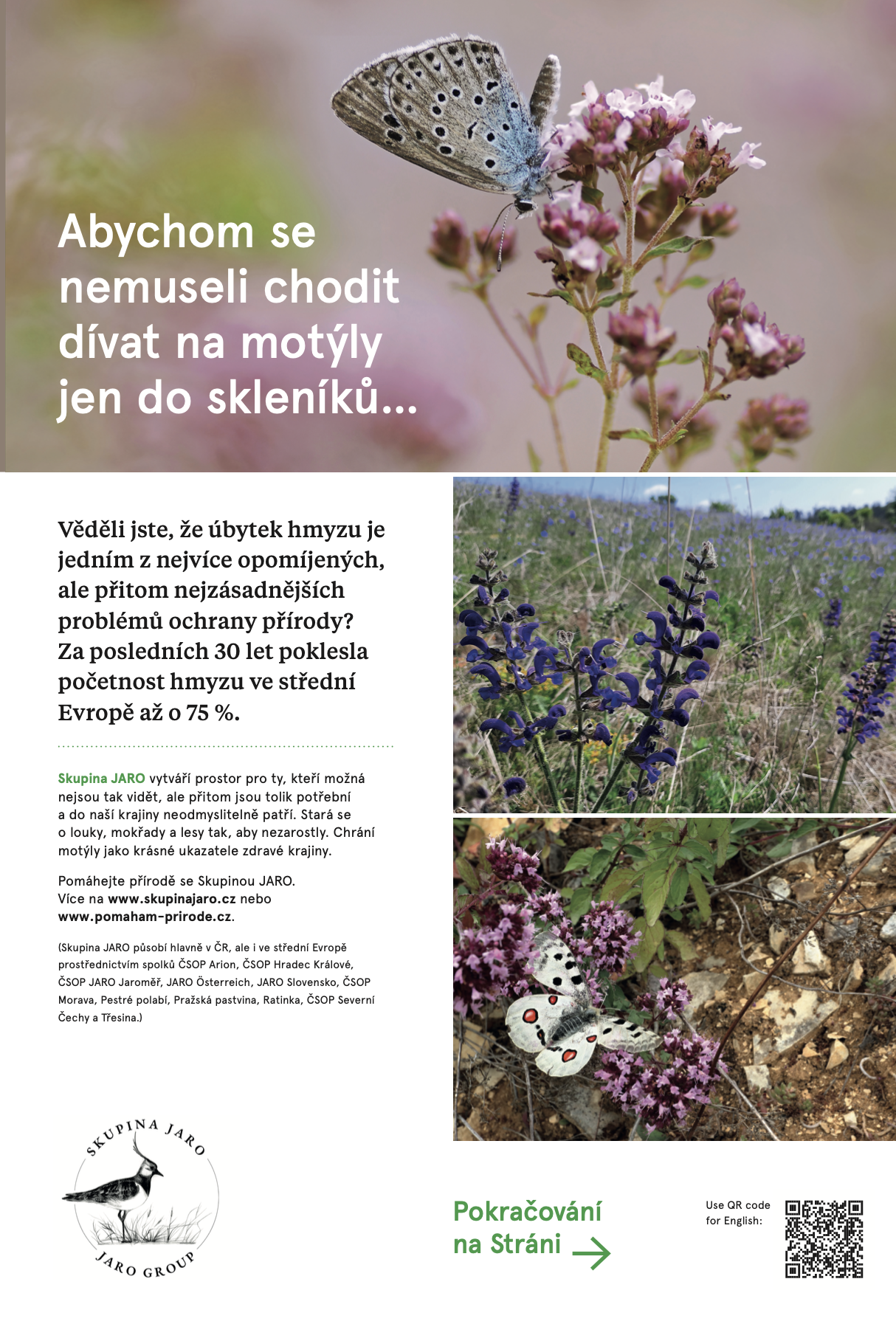
Did you know that the general population decline of insects is among the gravest, but at the same time most neglected, problems of conservation biology? In the past 30 years, insect numbers have fallen as much as 75% in Central Europe.
JARO Group protects the habitats of those creatures that may not be the most conspicuous, but that is nevertheless an inherent and vital part of our nature. Grasslands, wetlands, and forests are managed to ensure maximum diversity, while butterflies are protected as jewels that indicate the landscape's health.
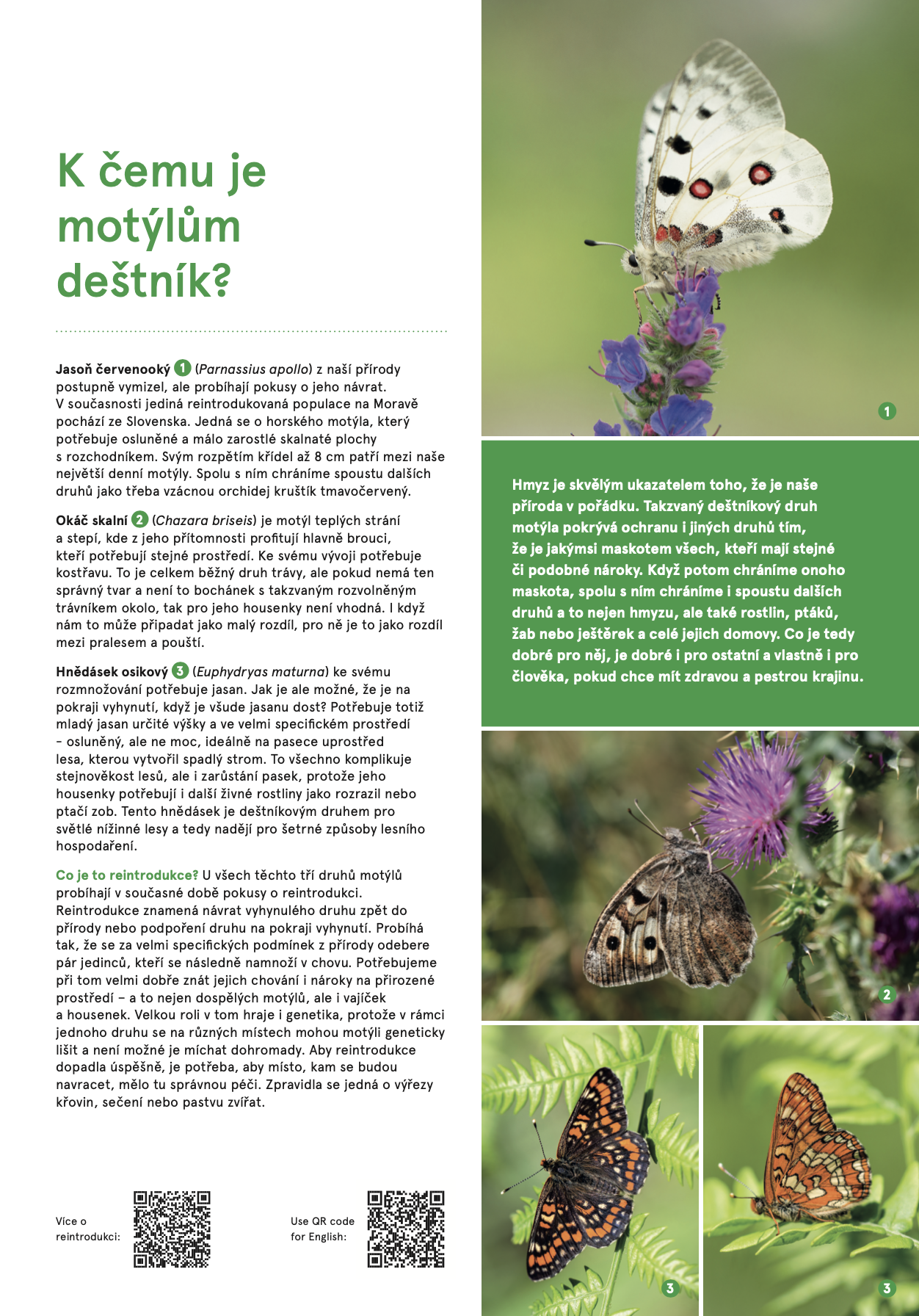
Insects are a superb indicator of the working order of our natural world. An umbrella species is a charismatic species (such as the butterfly) whose protection benefits other species with similar requirements. A popular and well-known species thus becomes a kind of mascot for all the lesser-known, but equally precious, organisms under its umbrella – not just insects, but countless members of all five kingdoms (plants, fungi, animals, Monera, and Protista), birds, amphibians, reptiles, and their entire habitats. What is good for the mascot is thus also good for others, including us, if we wish to have a healthy and diverse landscape.
The Apollo (1) (Parnassius apollo), with its wingspan of up to 8cm, is one of our biggest butterflies. Once widespread in Czechia, it has gone extinct, but there are efforts to aid its return. Currently, the only population in Moravia is a result of its reintroduction from Slovakia. It is a species of sunny, open, alpine habitat where its host plant – stonecrop – is present. Together with the Apollo, we protect many other species, such as the rare orchid royal helleborine (Epipactis atrorubens).
The Hermit (2) (Chazara briseis) is a butterfly of warm steppes and grassy hillsides. Its presence indicates a favorable environment for many species of beetles, which need the same conditions. Its food plant is fescue, a fairly common grass. However, in order to be suitable for its caterpillars, the grass patches have to be the right shape, known as sparse sod. This may seem like a minor detail to us, but to them, it is the difference between life and death.
The Scarce fritillary (3) (Euphydryas maturna) needs ash trees for its caterpillars. So why is it nearly extinct, despite ash being common everywhere? Because it needs young ashes of a certain height, ideally in a forest opening after a fallen tree. Moreover, its caterpillars need other food plants, such as speedwell (Veronica) and wild privet (Ligustrum). These conditions, granted in natural forests, are not found in the species-poor, uniform-age, closed-canopy tree farms that we call forests nowadays. This fritillary is an umbrella species for proper lowland forests, as they should be, and hope for close-to-nature forest management methods.
What is reintroduction? In all three of the species of butterflies mentioned, there are reintroduction attempts underway. Reintroduction means that an extinct or almost extinct species is returned back to nature. This is done by taking, under very specific conditions, a small number of individuals from an extant population to be multiplied in captivity. For that, we need to know their behaviors and requirements – not only for adults but also for eggs and caterpillars. The genetics of the species also needs to be taken into account, so as to use a genetically compatible population. For a reintroduction to be successful, the habitat usually needs to be carefully prepared. Mowing, animal grazing, and removing the shrub layer are often involved.
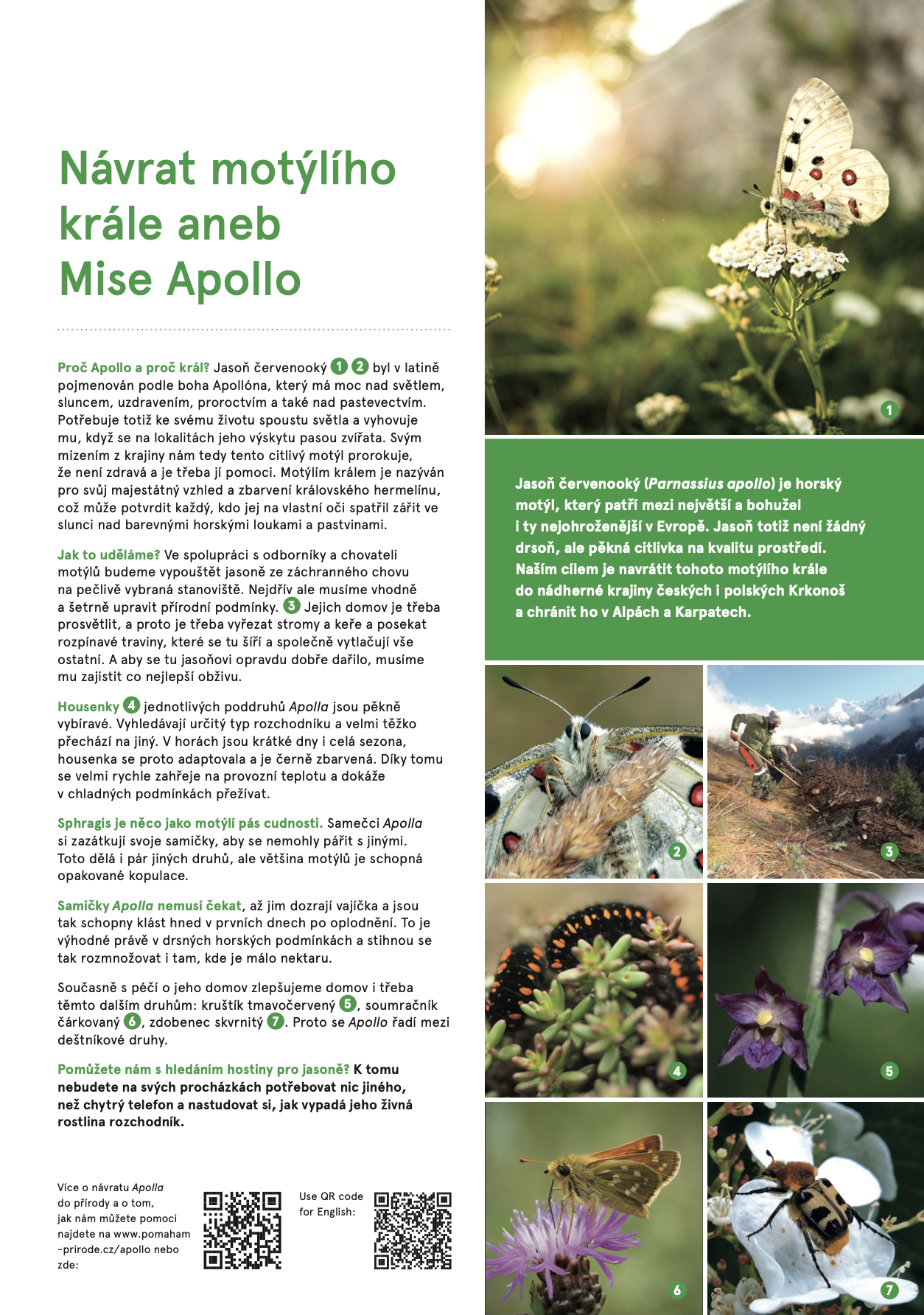
The Apollo (Parnassius apollo) is an alpine butterfly that is among the largest, and sadly also the most endangered, butterflies of Europe. That is because the Apollo is no tough fellow, but rather quite sensitive, at least to the quality of the environment. Our goal is to bring this butterfly king back to the majestic slopes of the Czech and Polish Giant Mountains (Krkonoše) and further its protection in the Alps and Carpathians.
Why Apollo and why the King? Apollo, the god after whom this butterfly is named, has power over the Sun, light, healing, and prophecy, but also pastures. Likewise, the Apollo butterfly needs a lot of light in its habitats and it generally benefits from grazing. The disappearance of this sensitive butterfly foretells us that the landscape is not well and needs help. It is called the King of the Butterflies for its majestic appearance and its color of royal ermine, which anyone who has seen it shine in the sun above the blooming alpine plains and pastures can attest to.
How do we do that? Working with experts and butterfly breeders, we will release butterflies from the rescue breeding into carefully selected habitats. But first, we have to adjust the natural conditions there. (3) Their new home needs light; therefore, trees, shrubs, and expansive grasses must be cleared out, so that they will not suppress everything else. Moreover, to make the Apollo truly thrive there, we have to provide it with the best possible nourishment.
Caterpillars (4) of the individual Apollo subspecies are picky eaters. They favor a certain species of stonecrop (Sedum, Hylotelephium, or Rhodiola) and have a hard time switching to another. Days are short in the mountains, and so is the entire growing season. Therefore, the caterpillar has adapted and is colored black. Thanks to this, it heats up faster and is able to live in a cold environment.
Sphragis is something like a butterfly chastity belt. Apollo males lock their females so they cannot mate with others. A few other species do this as well, but most butterflies are capable of repeated copulation. Apollo females do not have to wait for their eggs to mature – they are able to lay them within the first days after fertilization. This is advantageous in harsh mountain conditions – butterflies manage to reproduce even where little nectar is available.
While caring for its habitat, we are at the same time improving conditions for other species, such as the royal helleborine (5), silver-spotted skipper (6), and Eurasian bee beetle (7). For these and many others, the Apollo is their umbrella species. Will you help us find a feast for the Apollo? For this, you will need nothing more on your walks other than a smartphone and the ability to recognize its food plant – stonecrop.
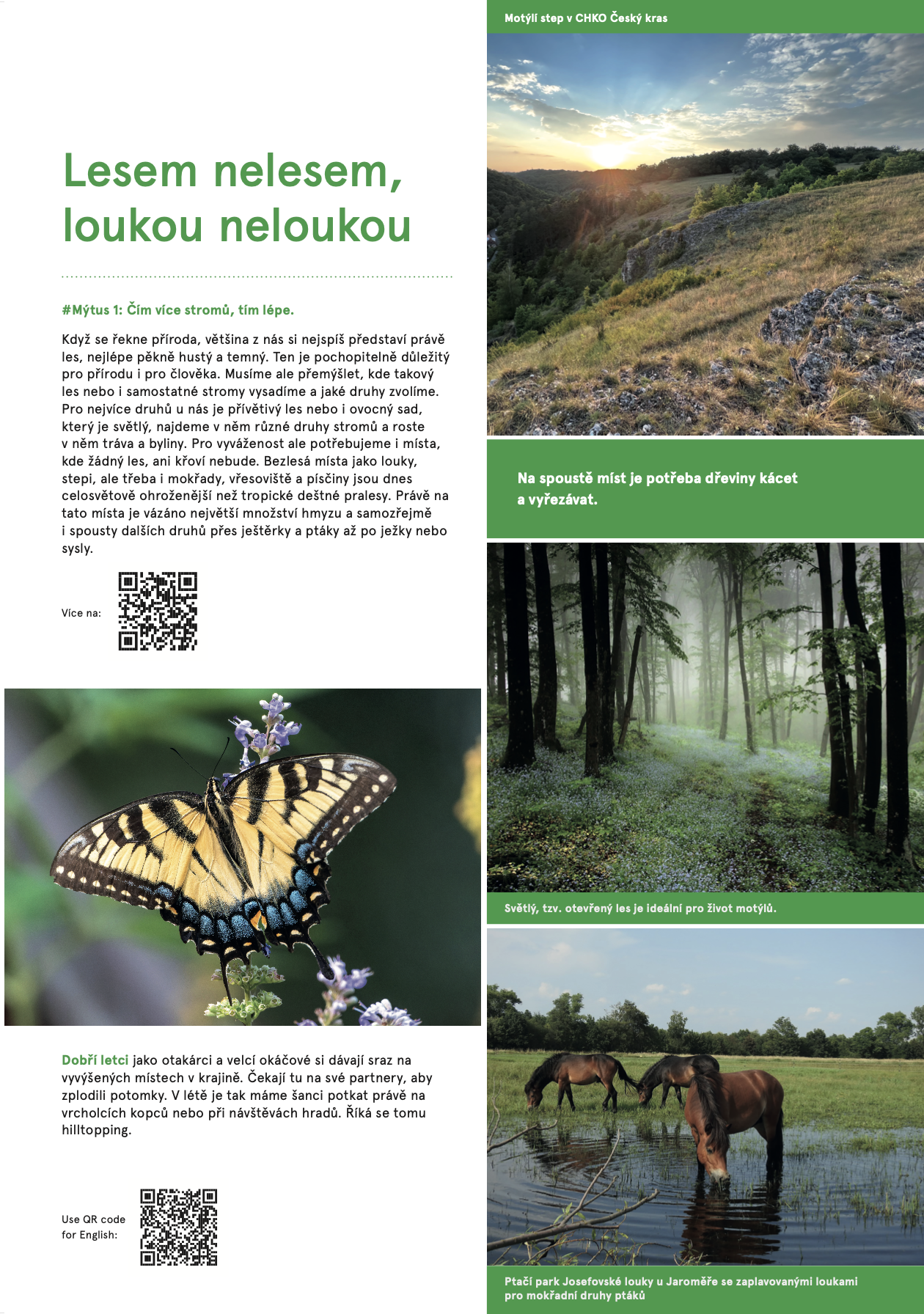
Myth #1: The more trees, the better
When talking about nature, many of us imagine a forest, preferably a dense and dark one. Of course, such forests are important. However, we need to think cautiously before planting forests or even solitary trees. Forests or even orchards that are thin and bright, with a thriving forest floor and a variety of trees, are usually the best for biodiversity. For natural balance, the landscape should include places dedicated solely to the herb layer in equal measure, with no trees or shrubs at all. These areas, such as meadows and steppes, but also wetlands, heaths, and sands, are more endangered globally than tropical rainforests. Together, these harbor more species than forests – not only species of insects but also many others, from lizards and birds to hedgehogs and ground squirrels.
Photo description: In many places, felling trees and clearcutting shrubs is necessary. / A bright, open forest canopy is ideal for most butterfly species. / Bird park Josefovské louky near Jaroměř with seasonally flooded meadows for wetland bird species
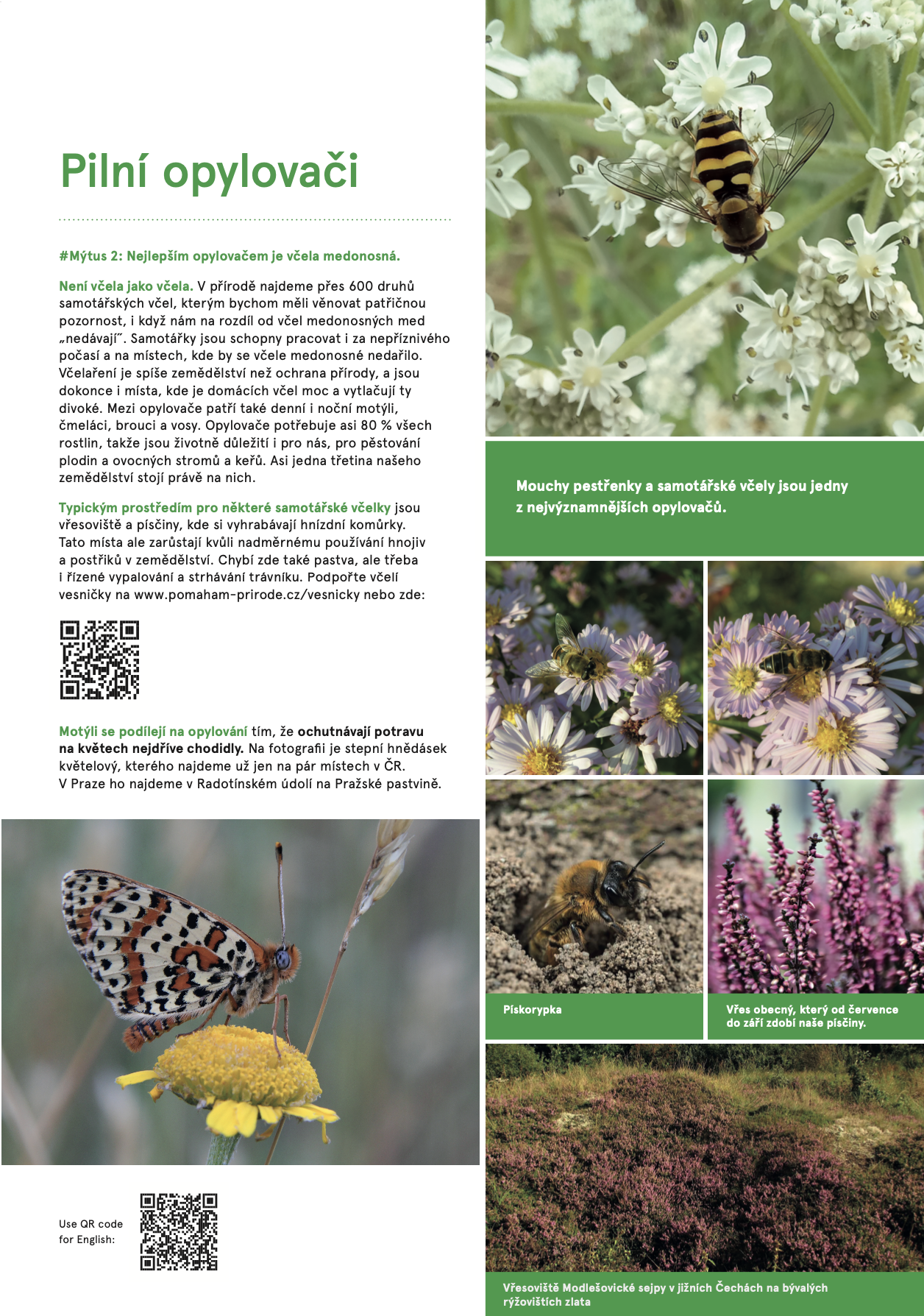
Myth #2: The best pollinator is the honeybee
Not all bees are created equal. In nature, there are over 600 species of solitary bees, and these deserve attention, even though they do not "give" honey. Solitaries are able to work even in bad weather and in places where honeybees would not thrive. Beekeeping is more agriculture than conservation, and there are even places where there are too many domestic bees, which crowd out the wild ones. Pollinators also include butterflies and moths, bumblebees, beetles, and wasps. Pollinators are needed by about 80% of all plants, so they are also vital for us, for the process of growing crops and fruit. About one-third of our agriculture depends on them.
The typical habitats of certain solitary bees are heaths and sandbanks, where they dig their nest chambers. However, these places are often overgrown due to the excessive use of fertilizers in agriculture. The missing factors include not only grazing but also controlled burning and mechanical sod disturbance. Support bee villages at www.pomaham-prirode.cz/vesnicky or here:
Butterflies take part in pollination by tasting flowers first with their feet. The photo shows a spotted fritillary, which can now only be found in a few places in the Czech Republic. In Prague, it is found in Radotín Valley, managed by Prague Pasture.
Photo description: Hoverflies and solitary bees are among the most important pollinators. / Solitary bee of the Andrena genus /Common heather, which decorates our sands from July to September. / Modlešovické sejpy heath in South Bohemia on former gold panning fields
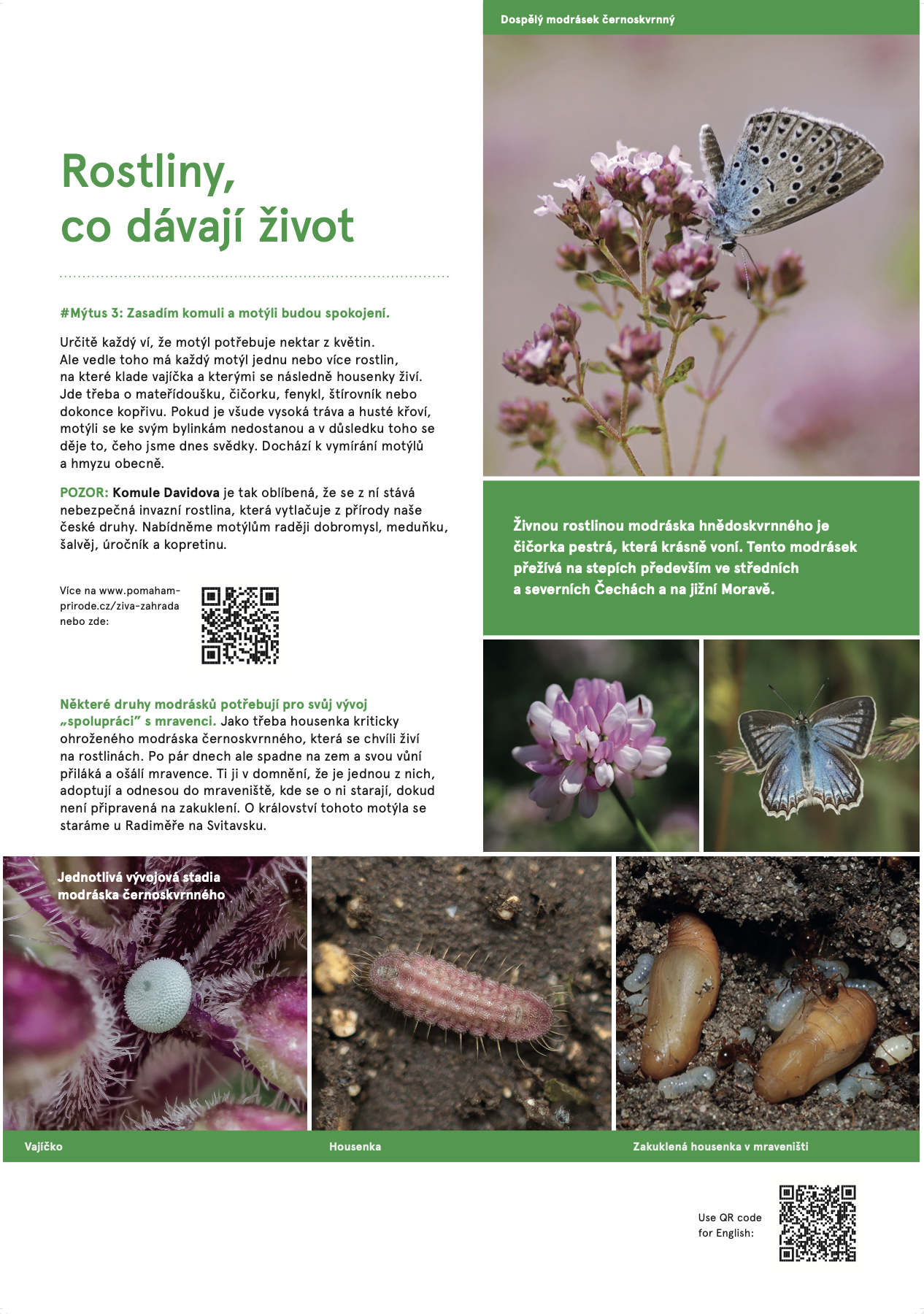
Myth #3: If I plant a butterfly bush, the butterflies will be happy
Surely, everyone knows that butterflies need nectar from flowers. But in addition, each butterfly has one or more food plants on which it lays its eggs and on which its caterpillars then feed. Common examples include thyme (Thymus), crown vetch (Coronilla), fennel (Foeniculum), bird’s-foot trefoil (Lotus), and even ordinary nettle (Urtica). However, if there is tall grass and thick bushes everywhere, butterflies will not get their herbs, and the result is what we see today: a steep decline in the number of butterflies and insects in general.
NOTE: The butterfly bush (Buddleja spp.) has become so popular that it is becoming a dangerous invasive plant, displacing native Czech species. Let’s offer our butterflies lemon balm (Melissa), wild marjoram (Origanum), sage (Salvia), kidney vetch (Anthyllis), and ox-eye daisy (Leucanthemum) instead.
Some species of blues need "cooperation" with ants for their successful development. An example is the critically endangered large blue, whose caterpillar first feeds on plants, but after a few days fall to the ground and use its scent to attract ants and get into their anthill, where it lives until ready to pupate. We look after the survival of this rare butterfly on a protected site near Radiměř in the Svitavy region.
Photo description: Adult large blue - The food plant of Meleager’s blue is purple crown vetch (Securigera varia), a sweet-smelling plant. This species survives mainly on the steppes in Central and Northern Bohemia and South Moravia. / The four stages in the life cycle of large blue. / Egg / Caterpillar / Pupa in an anthill
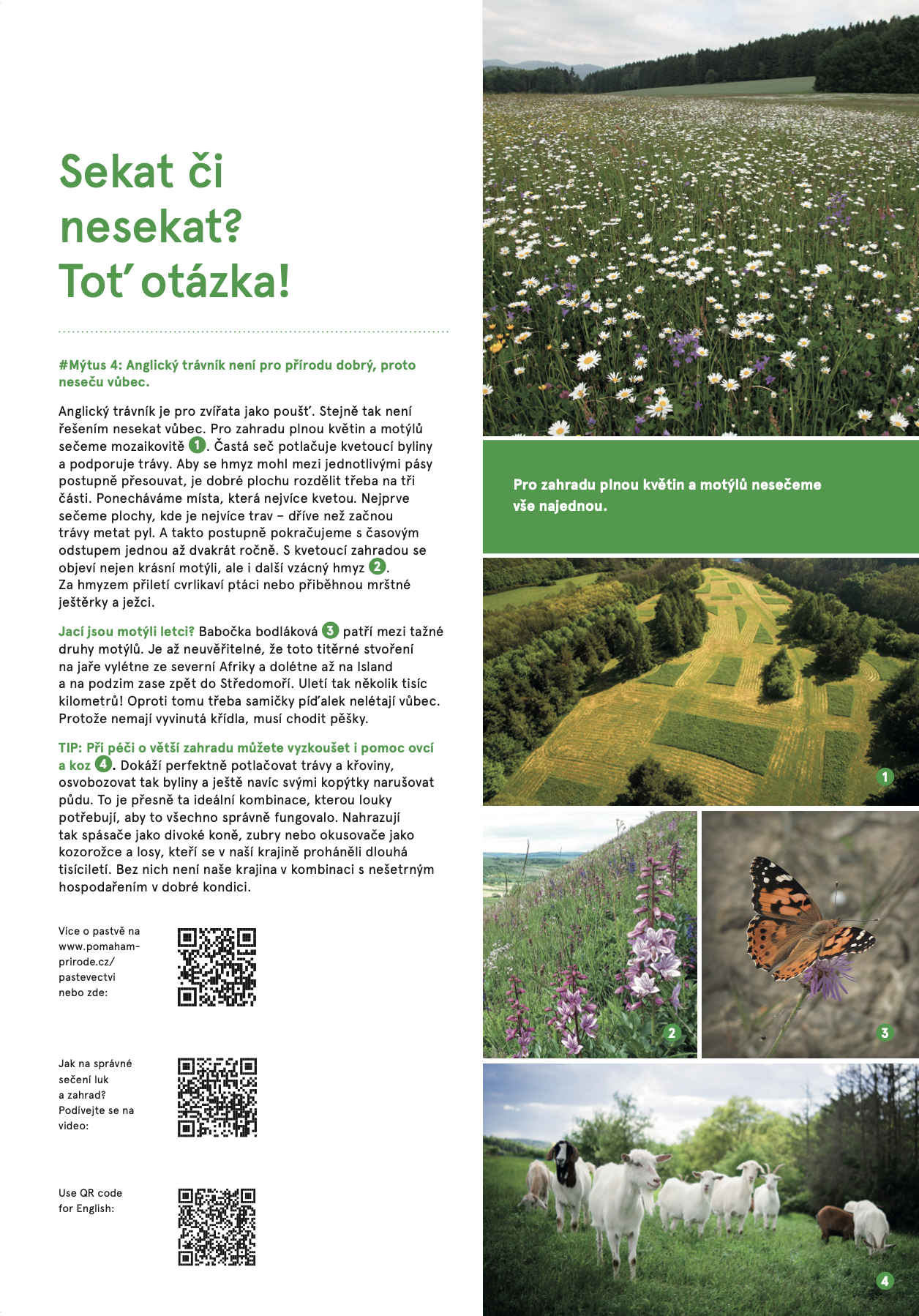
Myth #4: The "English" lawn is bad for nature, so I do not mow at all.
A closely cut "English" lawn is like a desert to animals. But not mowing at all is far from an ideal solution. For a garden full of flowers and butterflies, mosaic mowing is necessary (1). A frequent total cut suppresses flowering herbs and promotes grasses. To give insects a chance to move to hospitable areas, we divide the area into, let’s say, three parts. We leave out those with blooming herbs, mowing the grassiest part first – before it starts releasing pollen. And thus we continue in a certain time interval so that in the end, most of the area is mowed once or twice a year. A flowering garden will attract not only butterflies but also other rare insects (2). And after them, chirping birds, nimble lizards, and puffing hedgehogs will follow.
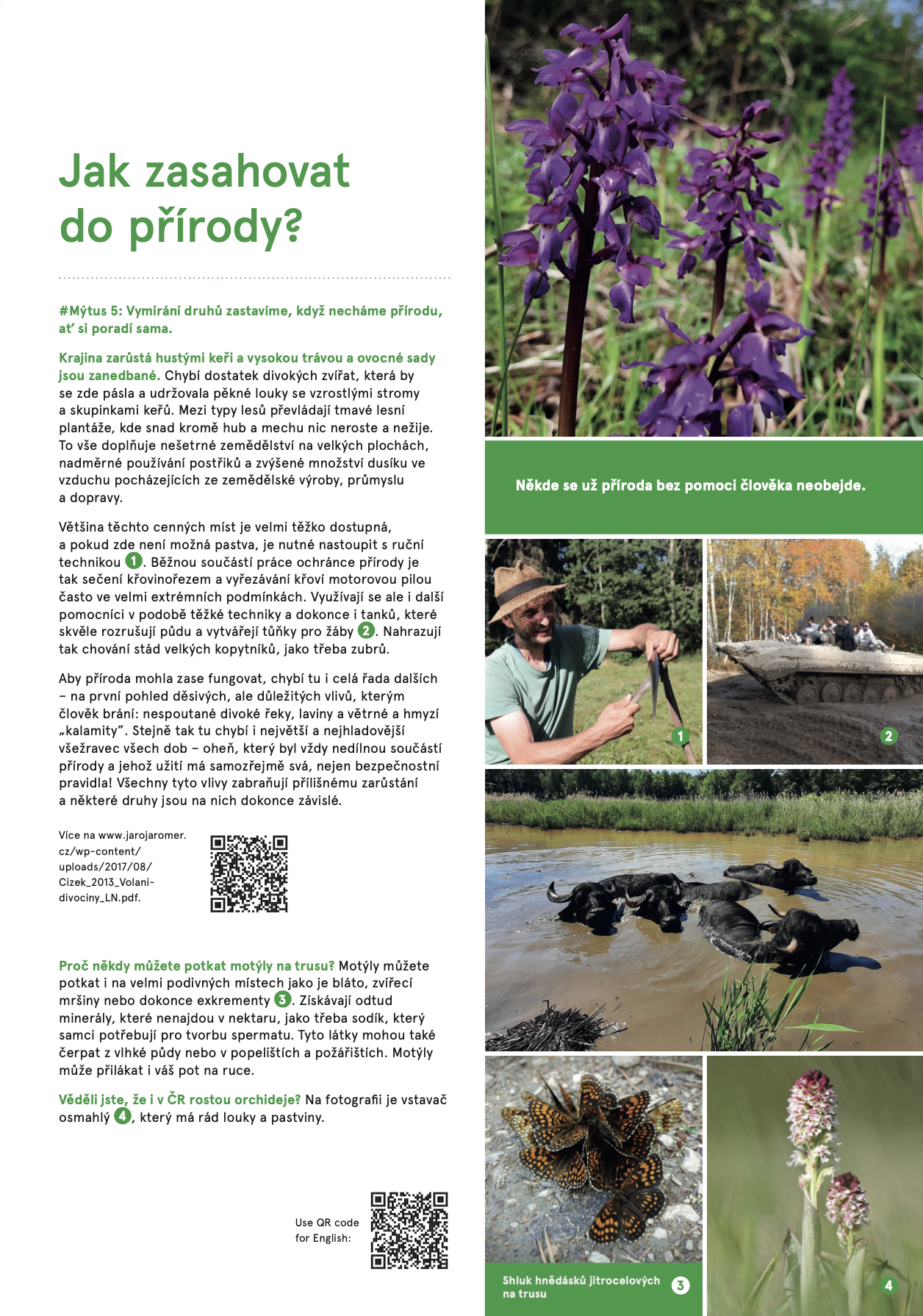
Myth #5: Species extinction will cease if we leave nature to itself.
The landscape is overgrown with thick shrubs and tall grass, and orchards are neglected. Wild animals alone are not enough to maintain nice meadows with a mosaic of mature trees and shrub patches. Forests are dark, with prevailing same-age tree plantations, where only moss and fungi grow. And all this is complemented by insensitive large-scale agriculture replete with chemistry and fertilizers as if the increased atmospheric amount of nitrogen oxides from combustion engines was not enough.
Many of these valuable spots are difficult to access, and if grazing is not possible, it is necessary to intervene with manual equipment (1). Working with a chainsaw and a brush cutter thus becomes the most common part of a practical conservationist’s job description, often in extreme terrain conditions. But other helpers are also used in the form of heavy equipment and even tanks, which are great at disturbing the soil and creating pools for frogs (2). They are a substitute for the herds of large ungulates, such as wisents.
In order for nature to get back to the state in which it should be, there are also a number of important phenomena that are perhaps frightening in the eyes of humans, and which they’d prefer to prevent: wild, swollen rivers, avalanches, wind, and insect "calamities." Also missing is the biggest and hungriest omnivore of all – fire, which has always been an integral part of nature and who plays by its own rules! All these phenomena are used to prevent excessive overgrowth, and some species are existentially dependent on them.
Why can we sometimes see butterflies on droppings? They can also be seen in very odd places, such as mud, carrion, and even excrement (3). They get minerals from them that they do not find in nectar, such as sodium, which males need to make semen. These substances can also be found in moist soil or in ash and fire pits. Butterflies can also be attracted to the sweat on our hands, not to mention our feet and socks.
Did you know that there are orchids in Czech nature? In the photo, there is a burnt-tip orchid (Neotinea ustulata) (4), whose preferred habitats are meadows and pastures.
Photo description: In some places, nature can no longer do without human help. / A group of heath fritillaries on droppings
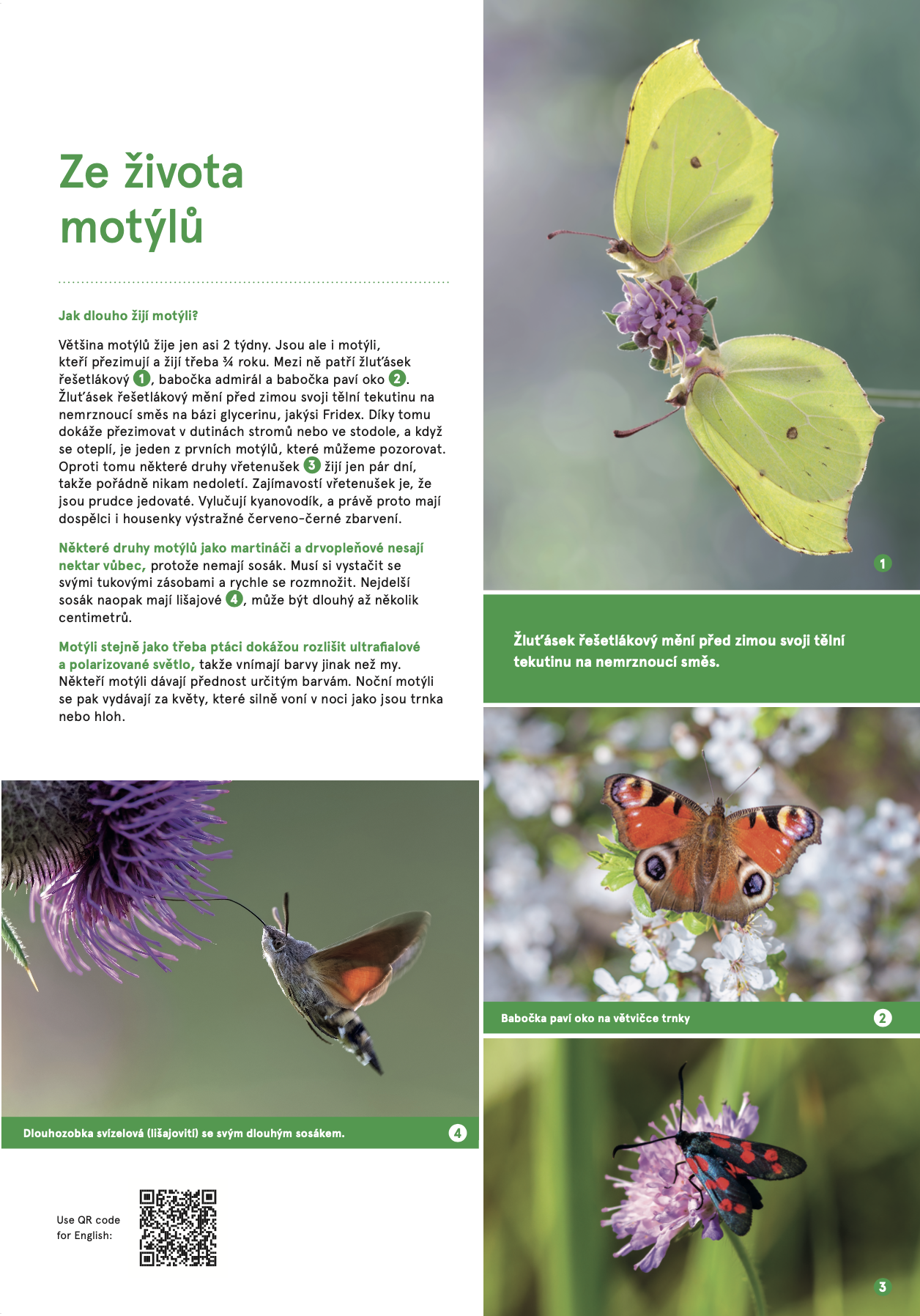
How long do butterflies live?
Most butterflies live for only about two weeks. However, there are also butterflies that hibernate and live for up to nine months. These include the common brimstone (1), red admiral, and European peacock (2). Before winter, the common brimstone changes its body fluid to a glycerin-based antifreeze. Thanks to this, it can overwinter in barns or hollow trees, and when the weather gets warmer, it is one of the first butterflies to be seen. On the other hand, some species of burnets (3) live only a few days, so they do not have time to fly too far. An interesting fact is that burnets contain a deadly poison – hydrogen cyanide – which both adults and caterpillars broadcast to would-be predators with their conspicuous coloration.
Some Lepidoptera, such as saturniid and cossid moths, do not feed at all as adults, since they have no functional proboscis. They rely on their fat reserves, and their adult life is dedicated to mating and reproduction. On the contrary, hawk moths have some of the longest proboscises – up to several centimeters.
Butterflies, like birds, can perceive ultraviolet and polarized light, so their color vision is different from ours. Butterflies prefer certain colors. Moths, on the other hand, rely on their sense of smell and visit flowers that give off a strong odor at night, such as blackthorn or hawthorn.
Photo description: The common brimstone changes its hemolymph into antifreeze fluid before winter. / European peacock on a blackthorn twig. / Hummingbird hawk-moth with its long proboscis.
Help us to protect nature with JARO Group. Learn more at www.jarogroup.org or www.pomaham-prirode.cz.
JARO Group mainly operates in the Czech Republic, but also in other countries of Central Europe, via its members:ČSOP Arion, ČSOP Hradec Králové, ČSOP JARO Jaroměř, JARO Österreich, JARO Slovensko (Slovakia), ČSOP Morava (Moravia), Pestré polabí (diverse Elbe), Pražská pastvina (Prague pasture), Ratinka, ČSOP Severní Čechy (Northern Czechia) and Třesina.
(ČSOP means the Czech Union for Nature Conservation, a civic association of people and affiliated associations.)